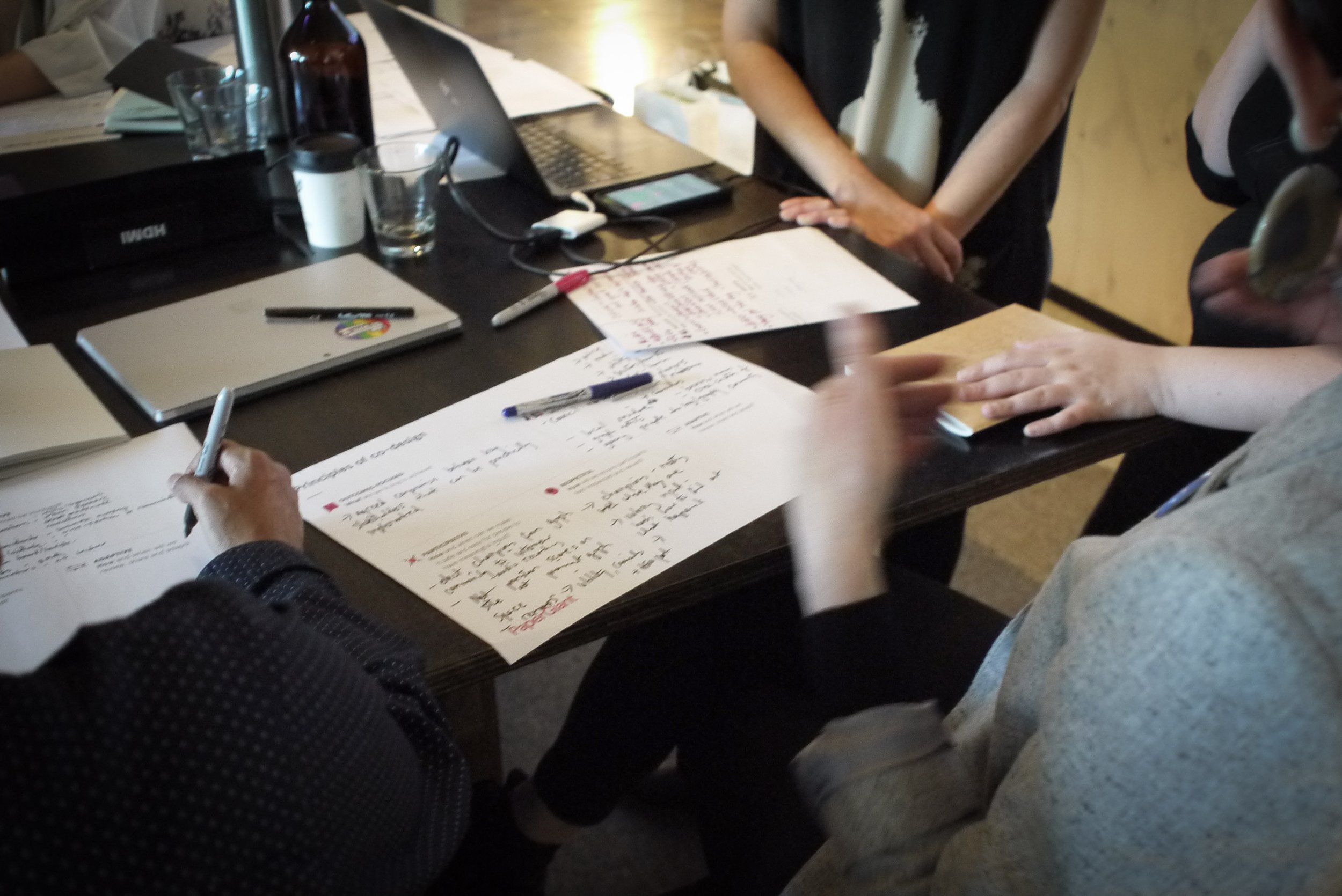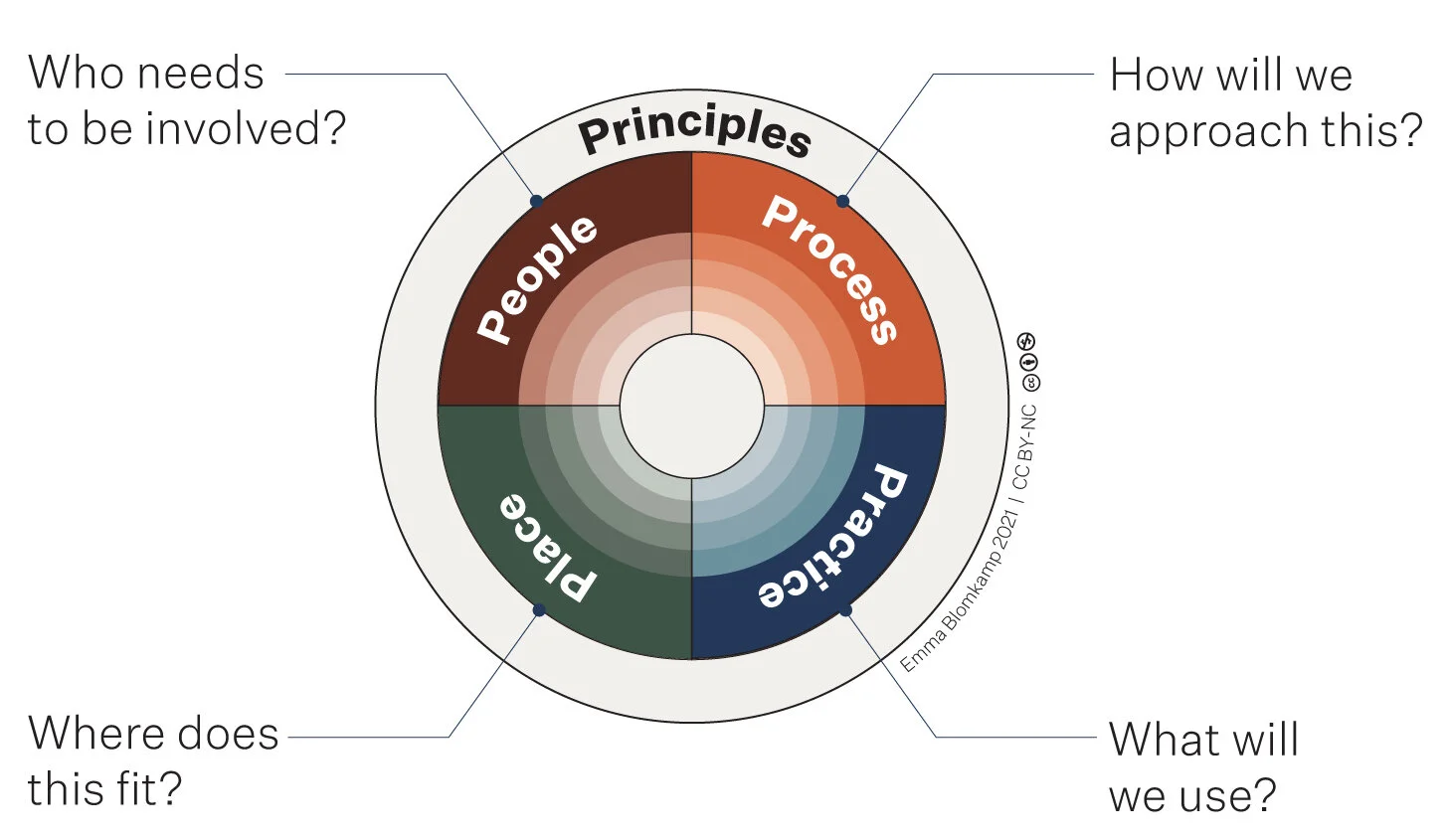The dance of systemic design
I’ve been working in the field of design for social innovation for about a decade now. From my formative experience learning on the job at innovate change, through research and evaluation roles, and more recently training and mentoring others in this practice, I’ve gained insight into how we can best build knowledge and skills in this unique way of working. My prior decade of experience in designing and delivering (not to mention participating in) educational programmes has also proven useful as I focus more and more on capability building initiatives.
This article offers some insights for those interested in strengthening their practice in systemic and social design. It focuses in particular on the Systemic Design Practice Wheel, and illustrates how each of its five domains offers considerations for practice, by comparing systemic design to a dance.
I have seen how human-centred design toolkits and process models like the double diamond provide useful entry points for people without professional training in design. Practical guides and online modules on systems practice can similarly offer an accessible approach and shared language for multidisciplinary teams working on systems change initiatives.
I’ve come across many people grasping for guidance in this complex field, often reaching for prefabricated toolkits or stage-based models to illuminate their path. These tools can sometimes do more harm than good, though.
I’ve found that an emphasis on principles or mindsets provides a more solid foundation for co-design and systemic design practice. While a craft cannot be summed up in one diagram or short online course, I have been trying to synthesise useful knowledge and practice wisdom in ways that support and encourage practitioners to learn through action and reflection.
Workshop participants scribe on and discuss the Co-Design Principles Canvas at SD Now (Melbourne, 2018).
I developed the Systemic Design Practice Wheel for this purpose. It emerged as an analytical tool to explain promising practice in a case study of participatory policymaking. It built on my earlier definition of co-design as a ‘process, practice and principles’, to introduce two domains that are too often overlooked: people and place. I have since found the Wheel is particularly useful as a framework to support project planning and practice reflection. I structure my short course Co-Design in Complex Systems around the 5 domains (aka the “5 Ps”) of this framework.
It is a compass, not a map
The Systemic Design Practice Wheel has been designed to orient practitioners, managers and commissioners towards ethical and effective ways of collaborating for social impact. It brings together insights from academic research, practical experience and program evaluation in (what I hope is) an accessible and succinct form.
It is not a step-by-step ‘how to’ guide. Nor is it a toolkit full of templates and techniques that can be deployed in any context. Rather, it is a set of considerations and questions that aim to guide both new and experienced design facilitators and teams tackling complex public problems.
There is no one-size-fits-all approach to social innovation or systems change. Yet there are things we can take on board from the rich history of scholarship and practice innovation in this and related fields.
Imagine systemic design is a dance
One way to think about systemic design is as a dance [1]. We can use the domains and prompts of the Systemic Design Practice Wheel to imagine how poorly you’d do if you didn’t know these things.
“I believe that we learn by practice. Whether it means to learn to dance by practicing dancing or to learn to live by practicing living, the principles are the same. In each, it is the performance of a dedicated precise set of acts, physical or intellectual, from which comes shape of achievement, a sense of one's being, a satisfaction of spirit. One becomes, in some area, an athlete of God. Practice means to perform, over and over again in the face of all obstacles, some act of vision, of faith, of desire. Practice is a means of inviting the perfection desired.”
Purpose (and other principles)
Why are you dancing? Are you taking part in Zumba as a way to get fit? Are you competing in a ballroom dance competition? Are you rehearsing for the ‘first dance’ at your wedding? Are you performing a haka to welcome a returning family member at an airport?
The purpose of your dance sets the tone and delineates right and wrong ways to proceed.
Place
When and where are you dancing? Are you inside or outside? On grass, on top of a table, or on a stage? What time of day is it? What’s the weather or temperature like? What’s happening before or after the dance?
All sorts of contextual factors like these will affect the dance.
People
Who is dancing? Who are you dancing with and/or for? How many people are dancing, and how many are watching? What are your roles in the dance? Is someone leading? How is this determined, e.g. by gender or experience? How might your physical attributes, attitude and skills shape how you dance?
Not everyone can or will dance the same way.
Process
How will you dance? Which style or type of dance is it (e.g. waltz, breakdancing, ballet, lindy hop)? In what order will you do things? What might you need to do before and/or after the dance? What kind of music or other sounds will guide or accompany the dance?
Depending on the kind of dance it is, you may have to follow certain conventions or perform certain steps.
Practice
What are the moves of the dance? How can you learn and rehearse them? Who might be able to help you? How well do you and others know the style? What should you learn or rehearse first?
“For the things we have to learn before we can do them, we learn by doing them.”
― Aristotle, The Nicomachean Ethics
Closing curtain
Like dance, systemic design (or co-design in complex systems, as I sometimes call it) is a craft. It cannot be learned simply by reading a book (or a blog, for that matter) or by watching a master at work (or on YouTube).
It must be practised. And the more you practise it – as long as you learn from your mistakes – the better you will get at it.
If you’re interested in design for social innovation and systems change, I hope this article has provided some ideas to apply and ponder. The Systemic Design Practice Wheel is freely available, with questions and a downloadable worksheet, designed to support people to strengthen their work through reflection and action.
We also explore and apply the framework in my short course, Co-Design in Complex Systems.
I’m always keen to hear from anyone who has used the framework, especially if you have any feedback about ways it has been useful or could be improved. You can comment below or get in touch here.
Footnotes
[1] I am not the first person to use this metaphor. Jon Osborne, for instance, who knows a lot more about dancing than I do, has written about the dance of design. Donella Meadows also famously talked about ‘dancing with systems’.



